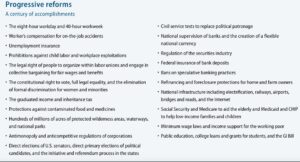In his New York Times column, “The Fear That is Shaping American Politics,” Thomas B. Edsall notes, “Robert Griffin, research director of the nonpartisan Democracy Fund Voter Study Group, wrote by email that he expects “the national environment to be worse for Democrats in 2022 than it was in 2020.” The shift, he continued, will almost certainly include a loss of support among white voters who — if history is any guide — will represent a larger share of the electorate in 2022 because of midterm turnout dynamics….Griffin wrote that “it’s not obvious to me that this shift will be dependent on Biden’s ability or failure to overcome white racial resentment,” because “these midterm dynamics are pretty baked in and it would be shocking to see them defied.”….On the plus side for Democrats, Griffin noted: The growing educational divide among white Americans does present an interesting opportunity for the Democratic Party. One of the things most people don’t appreciate is that white overrepresentation among voters is driven almost entirely by white college voters. This overrepresentation of white college voters is even greater in midterm elections. The growing educational divide among white voters — with Biden viewed much more favorably by white college voters — potentially blunts some of those midterm dynamics I described….I asked Griffin what the prospects are for Biden to build a stronger and more durable Democratic coalition. He is doubtful: If you had to pick one group that would do the most to solidify the democratic coalition electorally, it would be white non-college voters. They make up more than 40 percent of voters and are exceptionally well represented in the Electoral College, the House and the Senate….Biden, Griffin continued, improved slightly on Hillary Clinton’s margin among these voters, but it wasn’t anything massive. Given the long-term trends away from the Democratic Party among these voters, even holding onto his 2020 margins would likely represent an achievement.”
At Slow Boring, Matthew Yglesias makes a pretty convincing case that, contrary to popular beliefs, America’s transportation infrastructure, particularly roads and bridges, is not all that bad. Yglesias writes that “the existing surface transportation funding levels in the United States are inadequate. We have some of the best commute times in the world in an international context; our road quality is improving under current funding levels; and the biggest practical problem we have — endemic congestion in a few key metro areas — is not really amenable to being addressed with a big surge of funding.” Yglesias acknowledges that there is room for imrovement in mass rail transit in cities like New York, and notes, “What America’s bad traffic cities really need is congestion pricing, zoning that allows more people to live in convenient locations, and selective investments in improving mass transit capacity.” Yglesias would like to see more infrastructure investment on other more urgently-needed priorities, and notes “the same low population density that generally makes our commutes good has left us with subpar levels of mass broadband adoption. The challenge of moving electricity around is very real. Lead in water pipes is really bad. These infrastructure challenges are huge and much more important than roads and bridges. If the bill gets changed, it’s important to keep that stuff.”
In ‘keep doing what you’re doing, Mr. President’ news, Chelsea Cox reports at USA Today, “More Americans identify as Democrats than Republicans by a margin that hasn’t been seen in a decade, according to a report released by Gallup on Wednesday…An average of 49% of adults age 18 and older reported Democratic Party affiliation or said they are independent with Democratic leanings throughout the first quarter of 2021, the pollster reported. The survey was conducted by phone from January-March. In comparison, 40% of adults identified as Republican or Republican-leaning. The 9% difference is the Democrats’ largest advantage since the fourth quarter of 2012, according to the report. The remaining 11% of respondents were political independents with no partisan leanings….Democrats have typically held a 4 to 6 point advantage over Republicans. Shortly before the first quarter of the year, the gap in affiliation was virtually nonexistent before Democrats’ advantage widened by 9%….The report also noted a 6% increase in independents; from 38% in the fourth quarter of 2020 to 44% in the first quarter of 2021. It’s the highest percentage since 2013, when 46% of survey respondents identified as independents. The rise correlates with the decline in Republican Party identification, just as in 2013, when the GOP saw a drop in the popularity during the government shutdown over the Affordable Care Act.”
Democrats pondering a response to Mitch McConnell’s sanctimonious comments urging corporations to “stay out of politics” should check out former Secretary of Labor Robert Reich’s zinger: “Mitch McConnell continued his tirade against businesses who have spoken out against Georgia’s egregious voter suppression bill today, telling reporters that corporations should “stay out of politics.” Yes, you read that right….That’s rich, coming from one of the most outspoken supporters of the disastrous Citizens United Supreme Court decision, which allowed corporate cash and big money to flood unabated into our democracy. I suppose McConnell has no problem with “corporate free speech” when it’s benefiting him personally — he was, after all, the top recipient of corporate cash in the 2020 election cycle. And he even took a case all the way to the Supreme Court in 2003 because he was so determined to bring more corporate money into our political process. Republicans love corporations in politics when it means they’re bankrolling Republican campaigns — but as soon as corporations stand up against Republican hatred and bigotry, it’s time for them to be silent. The hypocrisy is staggering.”









